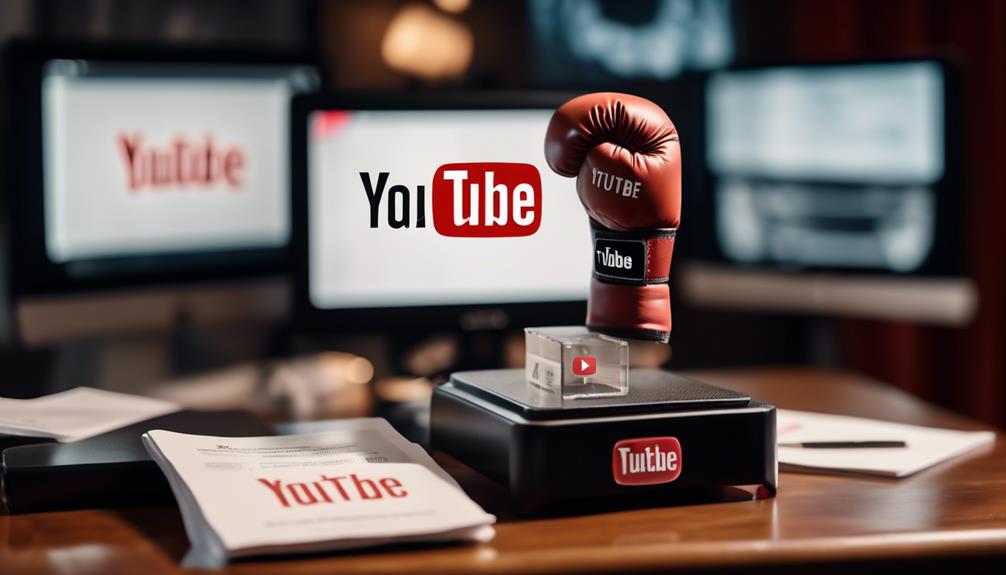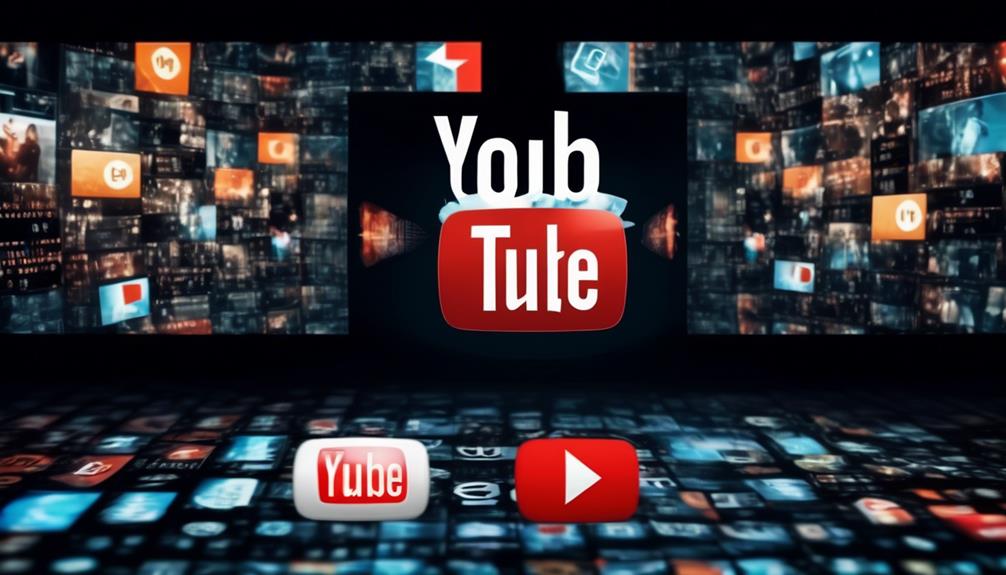
Can I post the same video on YouTube and Rumble?
Navigating the waters of content creation can be as tricky as sailing through stormy seas, especially when you’re unsure about cross-posting your videos on different platforms like YouTube and Rumble. You might be wondering if it’s possible, or even legal, to upload the same video to both of these popular sites.
Well, you’re not alone in this boat. Many creators are grappling with the same question, unsure of how to maximize their reach while staying within the bounds of each platform’s unique policies.
Let’s set sail on this voyage together, exploring the intricacies of cross-posting to help you chart the best course for your content.
Key Takeaways
- Abide by the guidelines and terms of service of both YouTube and Rumble to avoid penalties and account suspension.
- Cross-posting can be beneficial to reach different audience segments, increase engagement, and diversify revenue streams.
- However, consider copyright and platform policies before cross-posting and adapt your content for each platform to optimize engagement.
- It is important to respect copyright and ownership rights by seeking permission, understanding fair use policies, and valuing the work of others.
Understanding YouTube’s Terms of Service

Before you start posting videos on YouTube, it’s crucial that you understand their Terms of Service to ensure you’re not violating any rules or regulations. You’re expected to abide by these guidelines, and failure to do so can lead to penalties, including the removal of your content or the suspension of your account.
YouTube’s Terms of Service outline several important points, such as the prohibition of harmful or dangerous content. This includes videos promoting violence, illegal activities, or content that could physically harm or distress viewers. You’re also required to respect copyright laws. Simply put, you can’t use someone else’s work without their permission or appropriate credit.
Furthermore, as an innovative content creator, you’ll want to pay close attention to YouTube’s community guidelines. They emphasize the importance of respect and kindness, discouraging behavior such as harassment or hate speech. Understanding these rules isn’t just about avoiding penalties, but also about creating a positive and engaging environment where your innovative content can thrive.
In essence, understanding and respecting YouTube’s Terms of Service isn’t just a requirement, but a pathway to creating content that truly resonates with your audience.
Diving Into Rumble’s User Policies
Just as with YouTube, navigating Rumble’s user policies is a crucial step you’ll need to undertake before sharing your content on this burgeoning platform. Rumble’s guidelines are designed to protect both creators and viewers, ensuring a fair, safe, and innovative digital landscape.
Rumble encourages original content, but it’s okay if you want to share the same video on both platforms. However, you must own the rights to the video or have permission from the rightful owner. Remember, Rumble isn’t a fan of deceptive practices. So, don’t mislead viewers with inaccurate titles or thumbnails.
You’ll also need to steer clear of explicit content. Rumble strives for a respectful, inclusive environment. Hate speech, harassment, or any form of discrimination won’t be tolerated.
Rumble also takes copyright issues seriously. If you’re using someone else’s content, ensure you’ve secured the necessary rights or permissions. Plagiarism isn’t just frowned upon—it’s prohibited.
Cross-Posting: What Does It Mean?

In the world of content sharing, you might have heard the term ‘cross-posting’, but what exactly does it mean? Essentially, cross-posting involves sharing the same content across multiple platforms. You could, for instance, post a video on YouTube and then share the same video on Rumble. This strategy can be an effective way to maximize your content’s reach and visibility.
With cross-posting, there are some key considerations to bear in mind. Let’s explore these in the table below:
| Key Consideration | Description |
|---|---|
| Copyright | Ensure you have the rights to share the content on all chosen platforms. |
| Platform Policies | Different platforms have different rules about cross-posting. Always read the fine print. |
| Audience Engagement | Gauge whether your content aligns with the audience on each platform. |
| Optimization | Tailor your content’s presentation for each platform to fully leverage its features and algorithms. |
Factors to Consider Before Cross-Posting
When you’re gearing up to cross-post, it’s crucial to weigh a few key factors to ensure your content hits the mark on every platform. Firstly, consider the platform-specific audience. YouTube and Rumble have different demographics and content preferences. Tailoring your video’s description or title to suit each platform’s audience can boost engagement.
Next, think about the video’s length and format. While Rumble welcomes longer videos, YouTube users often prefer shorter, snappier content. You might need to edit your video to fit each site’s format. Similarly, the platforms differ in their monetization policies. Understand each site’s rules to ensure you’re not violating any guidelines and to maximize your earning potential.
Furthermore, consider SEO. Keywords that work on YouTube may not be as effective on Rumble. Do your research to optimize your video’s visibility on each platform.
Lastly, timing is everything. Release schedules can significantly impact views and engagement. Analyze your audience’s behavior to determine the best time to post.
Potential Benefits of Cross-Posting

Cross-posting your content on multiple platforms such as YouTube and Rumble can offer a myriad of advantages, significantly boosting your online visibility. This strategic move can be a game-changer in your digital marketing pursuits, given the innovative nature of the current digital landscape.
- Increased Reach: By posting on multiple platforms, you’re able to reach different audience segments. Each platform has its unique demographic, thus broadening your potential viewership.
- Greater Engagement: With more platforms, there’s a higher chance of audience interaction. This can lead to increased likes, shares, and comments, fostering a more engaging online presence.
- Better SEO: Cross-posting can improve your search engine optimization. The more places your content appears, the more likely it’ll show up in search results, driving organic traffic to your content.
- Diversified Revenue Stream: Platforms like YouTube and Rumble have monetization options. More platforms mean more revenue channels, which can enhance your overall earnings.
Possible Drawbacks of Cross-Posting
While cross-posting can amplify your online presence, it’s important to consider a few potential pitfalls.
You might run into copyright issues if you’re not careful about the content you’re sharing across platforms.
Moreover, your viewer engagement could decrease if your audience feels overwhelmed by seeing the same content repeatedly.
Potential Copyright Issues
One critical aspect you’ll need to consider as you venture into cross-posting videos on YouTube and Rumble is the potential for copyright issues. These platforms operate under different copyright policies, which could complicate your posting plans.
Here’s what you need to know:
- YouTube has a strict copyright policy, and violations can lead to your video being taken down or your account suspended.
- Rumble, on the other hand, is more lenient but still respects copyright laws.
- Cross-posting could lead to viewers or the platforms themselves flagging your content as duplicate, which might affect your visibility.
- If you’re using third-party content, ensure you have the necessary permissions to avoid potential legal issues.
Stay informed, mindful, and proactive when cross-posting to protect your content.
Diminishing Viewer Engagement
Despite its advantages, you might find that cross-posting on YouTube and Rumble can lead to a decrease in viewer engagement, presenting a significant drawback to this approach.
| Drawback | Description |
|---|---|
| Repetition | Viewers may feel overwhelmed by seeing the same content, leading to a decrease in excitement and engagement. |
| Decreased Exclusivity | Cross-posting might strip your content of its exclusivity, causing viewers to lose the sense of uniqueness. |
| Algorithm Consequences | Both platforms use algorithms that might penalize cross-posting, impacting visibility and reach. |
| Diluted Community | By splitting your audience, the sense of community could be diluted, affecting the social aspect of your content. |
Therefore, it’s essential to consider these potential pitfalls and weigh them against the benefits before deciding on a content distribution strategy.
Respecting Copyright and Ownership Rights

When you’re posting videos on platforms like YouTube and Rumble, it’s important to be mindful of copyright and ownership rights. Understanding digital copyright laws can help you avoid unintentionally infringing on someone else’s creative work.
Understanding Digital Copyright Laws
Navigating the complex world of digital copyright laws, it’s crucial that you respect both copyright and ownership rights when posting videos on platforms like YouTube and Rumble. Understanding these laws can protect you from potential legal consequences.
- Copyright Infringement: Uploading a video that isn’t yours without permission is illegal. Always seek the creator’s consent first.
- Fair Use Policy: This allows you to use copyrighted content under specific conditions. However, it’s complex and often misunderstood.
- Public Domain: Content in the public domain isn’t protected by copyright laws. You’re free to use it.
- Creative Commons: This license provides creators a way to share their works legally while retaining some rights.
Staying informed about these laws is key to a successful and respectful digital presence.
Video Ownership Importance
Understanding the importance of video ownership and respecting copyright and ownership rights isn’t just about avoiding legal trouble, it’s also about acknowledging and valuing the hard work and creativity of others.
When you respect these rights, you’re fostering an environment that encourages innovation and creativity. The fruits of someone’s labor, their intellectual property, are to be appreciated, not stolen.
If you’re considering posting the same video on YouTube and Rumble, always ensure you have the rights to do so. A disregard for video ownership can lead to penalties, content removal, and damage to your reputation.
In the world of digital content, playing by the rules isn’t just ethical, it’s essential for long-term success.
Consequences of Rights Violation
Frequently, violating copyright and ownership rights can lead to severe consequences, which you must understand before posting any content online.
- Legal Consequences: You might find yourself in a lawsuit, facing hefty fines, or even criminal charges.
- Financial Losses: The monetary implications can be significant. Besides court fines, you may have to pay damages to the original content owner.
- Reputation Damage: Your credibility can be irreparably damaged, making it challenging to regain your audience’s trust.
- Platform Restrictions: YouTube or Rumble could suspend or delete your account, limiting your ability to share new content.
Stay innovative, but respect others’ work. Remember, proper acknowledgment and permission can save you from these potential pitfalls.
Case Study: Successful Cross-Posting Strategies

Leveraging both YouTube and Rumble for your video content can significantly boost your online visibility, as proven by several success stories we’re about to explore. Both platforms offer unique advantages and, when utilized together, can form an unbeatable strategy.
One key to successful cross-posting is understanding the unique audience and algorithm nuances each platform offers. Here’s a table illustrating the strategies of three successful creators:
| Creator | YouTube Strategy | Rumble Strategy |
|---|---|---|
| Creator A | Highly edited, 10+ min videos | Short, unedited clips |
| Creator B | Product reviews & tutorials | Behind-the-scenes footage |
| Creator C | Full-length documentaries | Trailers and sneak peeks |
Creator A, for example, caters to YouTube’s algorithm favoring long-watch times, while also feeding Rumble’s preference for short, topical content. Creator B uses YouTube for conventional content, but offers a more personal touch on Rumble. Creator C leverages the anticipation built on Rumble to direct traffic to their longer YouTube videos.
How Algorithms React to Duplicate Content
You might wonder how algorithms react to duplicate content on YouTube and Rumble. It’s crucial to understand the penalties associated with duplicate content and how these penalties differ between platforms.
Let’s explore strategies to avoid duplication and maintain the integrity of your video content across platforms.
Understanding Duplicate Content Penalties
In the vast world of online content, it’s crucial to grasp how search engine algorithms respond to duplicate content and the penalties they impose. When you post the same video on both YouTube and Rumble, you might wonder if this could lead to a hit on your visibility or search engine ranking. Here’s what you should know:
- Search engines prefer unique content: They’re designed to provide value to users, and duplicate content can be perceived as spammy.
- Penalties can be severe: This can range from a lower ranking to removal from search engine results altogether.
- Not all duplicate content is penalized: If it’s evident that the intent isn’t manipulative, penalties mightn’t apply.
- Prevention is key: Use unique descriptions and titles for each platform to avoid detection.
Algorithm Differences: Youtube Vs Rumble
Having understood the implications of duplicate content penalties, let’s now explore how the algorithms of YouTube and Rumble react to such duplicate content.
YouTube’s algorithm, known for its sophistication, can detect duplicate content quickly and may consequently lower your video’s visibility or even take it down.
On the other hand, Rumble, with its newer platform, doesn’t have as stringent an algorithm for detecting duplicates. However, it’s crucial to note that this doesn’t mean Rumble supports duplicate content.
Similar to YouTube, Rumble also values unique content and its algorithm is designed to promote originality. So, while you technically can post the same video on both platforms, the algorithms’ responses mightn’t favor your content’s visibility.
Strategies to Avoid Duplication
To maintain your content’s visibility and avoid falling foul of algorithmic penalties, consider diversifying your video content across platforms instead of posting duplicates. This approach helps you to engage different audiences and maximizes your content’s reach.
Here are four innovative strategies to avoid duplication:
- Create unique titles and descriptions: Even if your video content is similar, unique titles and descriptions can make a difference in how algorithms perceive your content.
- Repurpose content: Transform your video into different formats such as podcasts, blogs, or infographics for various platforms.
- Space out your postings: Schedule your video uploads at different times across platforms.
- Engage with your audience differently: Tailor your call-to-action or interaction based on what works best for each platform.
Exploring Other Video Sharing Platforms
While YouTube and Rumble are popular choices, it’s important that you also explore other video sharing platforms to maximize your online presence. Diverse platforms offer different features and user bases that can help widen your reach and enhance your brand visibility.
Consider Vimeo, for instance. Known for its high-quality video content, it’s a great platform if you’re aiming for a professional or creative audience. It also lacks the intrusive ads that can disrupt your video’s flow, giving your viewers a more seamless experience.
There’s also Dailymotion, a platform that’s popular in Europe and boasts a user-friendly interface. If you’re targeting a global audience, this platform could be a suitable choice.
You might also want to check out TikTok, a platform that thrives on short, engaging, and often funny videos. It’s particularly popular among the younger demographic, making it an ideal choice if that’s your target audience.
Choosing the right platform depends on your specific goals and target audience. So, don’t limit yourself to YouTube and Rumble. Venture out and explore the vast digital landscape of video sharing platforms. Remember, it’s all about finding the right mix that works for your brand.
Rethinking Your Content Strategy

As you navigate the world of video sharing platforms, it’s crucial to constantly re-evaluate and refine your content strategy to ensure it remains relevant and effective. In the bustling digital landscape, sticking to the same plan isn’t just uninspiring—it’s also a recipe for stagnation. Consider these four steps to revitalize your strategy:
- Identify your core audience: Understand who they are, what they want, and how they consume content. Use this data to tailor your videos specifically to their tastes and preferences.
- Analyse your content’s performance: Utilize analytics tools to identify which of your videos resonate with your audience. Learn from your successes—and your failures—to improve future content.
- Experiment with different formats: Don’t limit yourself to a single type of content. Dabble in tutorials, vlogs, animations, or live streams. The variety can keep your audience engaged and attract new viewers.
- Leverage both platforms: YouTube and Rumble have different demographics and functionalities. Use these to your advantage by adapting your content to each platform’s unique audience.
Innovation is key in digital space. Challenge the status quo, push your creative boundaries, and you’ll build a stronger, more engaging content strategy.

